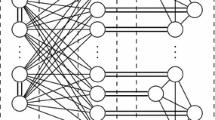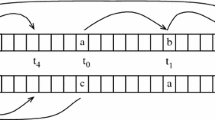Abstract
This paper deals with the quality of approximative solutions for the Subset-Sum-Maximization-Problem maximize
subject to
wherea l,...,an,bεR+ andx l,...xnε{0,1}. produced by certain heuristics of a Greedy-type. Every heuristic under consideration realizes a feasible solution (x 1, ..., xn) whose objective value is less or equal the optimal value, which is of course not greater thanb. We use the gap between capacityb and realized value as an upper bound for the error made by the heuristic and as a criterion for quality.
Under the stochastic model:a 1, ..., an, b independent,a 1...,an uniformly distributed on [0, 1], b uniformly distributed on [0,n] we derive the gap-distributions and the expected size of the gaps.
The analyzed algorithms include four algorithms which can be done in linear time and four heuristics which require sorting, which means that they are done inO(nlnn) time.
Zusammenfassung
Diese Arbeit untersucht die Güte von Näherungslösungen für das Subset-Sum-Maximierungsproblem maximiere
unter
wobeia l,...,an,bεR+ andx l,...xnε{0,1}. welche von bestimmten Greedy-Heuristiken erzeugt werden. Jede dieser Heuristiken realisiert eine zuverlässige Lösung (x1, ..., xn), deren Zielfunktionswert den Optimalwert nicht übertrifft und letzterer ist sicher nicht größer alsb. Die Lücke zwischen der Kapazitätb und dem realisierten Wert stellt also eine obere Schranke für den Fehler und somit ein Qualitätskriterium dar.
Unter dem stochastischen Modell: a1, ..., an,b unabhängig, a1, ..., an gleichverteilt auf [0, 1],b gleichverteilt auf [0,n], ermitteln wir die Verteilungen der Lücke und ihre Erwartungswerte. Unter den analysierten Algorithmen befinden sich vier, die in linearer Zeit ausgeführt werden können. Weitere vier erfordern eine Vorsortierung, so daß sie O(nlnn) an Zeit benötigen.
Similar content being viewed by others
References
Borgwardt K H (1987) “Probabilistic analysis of optimization algorithms — Some aspects from a practical point of view”, Acta Applicandae Mathematicae 10 (1987): 171–210.
Coffman E G, Jr., Fayolle G, Jacquet P & Robert P (1989) “Largest-first sequential selection with a sum constraint”, Report of AT & T Bell Laboratories, Murray Hill, New Jersey, 1989.
Coffman E G, Jr., Lueker G S & Rinnooy Kan A H G (1986) “An introduction to the probabilistic analysis of sequencing and packing heuristics”, Report 8602/A, Econometric Institute, Erasmus Universiteit Rotterdam, Rotterdam.
D'Atri G & Di Rende A (1980) “Probabilistic analysis of knapsack-type problems”, Methods of Operations Research 40 (1980): 279–282.
D'Atri G & Puech C (1982) “Probabilistic analysis of the subset-sum problem”, Discrete Applied Mathematics 4 (1982): 329–334.
Garey M R & Johnson D S (1979) “Computers and Intractability: A Guide to the Theory of NP-Completeness”, Freeman, San Francisco, 1979.
Grötschel M, Lovász L & Schrijver A (1988): Geometric Algorithms and Combinatorial Optimization, Springer, Heidelberg, 1988.
Ibarra O H & Kim C E (1975) “Fast approximation algorithms for the knapsack and sum of subset problems”, Journal of the Association for Computing Machinery 22 (1975): 463–468.
Johnson D S (1984) “Approximation algorithms for combinatorial problems”, Journal of Computer and System Sciences 9 (1984): 256–278.
Lagarias J C & Odlyzko A M (1985) “Solving low-density subset-sum problems”, Journal of the Association for Computing Machinery 32 (1985): 229–246.
Lawler E L (1979) “Fast approximation algorithms for knapsack problems”, Mathematics of Operations Research 4 (1979): 339–356.
Martello S & Toth P (1977) “An upper bound for the zero-one knapsack problem and a branch and bound algorithm”, European Journal of Operations Research 1 (1977): 169–175.
Martello S & Toth P (1984) “Worst-case analysis of greedy algorithms for the subset-sum problem”, Mathematical Programming 28 (1984): 198–205.
Martello S & Toth P (1985) “Approximation schemes for the subset-sum problem: Survey and experimental analysis”, European Journal of Operations Research 22 (1985): 56–69.
Szkatula K & Libura M (1983) “Probabilistic analysis of simplex algorithms for binary knapsack problems”, Control and Cybernetics 12 (1983): 147–158.
Szkatula K & Libura M (1986) “Probabilistic properties of threshold and greedy algorithms for the binary knapsack problem”, Report 126, Polska Akacemia Nauk, Instytut Badan Systemowych, Warszawa.
Szkatula K & Libura M (1987) “On probabilistic properties of greedy-like algorithms for the binary knapsack problem”, Report 154, Polska Akacemia Nauk, Instytut Badan Systemowych, Warszawa.
Tinhofer G (1984) “Probabilistische Ansätze in der diskreten Optimierung”, Berichte der Mathematisch-Statistischen Sektion in der Forschungsgesellschaft Joanneum, Bericht Nr. 230, 1984.
Tinhofer G & Schreck H (1986) “The bounded Subset Sum Problem is almost everywhere randomly decidable in O(n)”, Information Processing Letters 23 (1986): 11–17.
Author information
Authors and Affiliations
Rights and permissions
About this article
Cite this article
Borgwardt, K.H., Tremel, B. The average quality of greedy-algorithms for the Subset-Sum-Maximization Problem. ZOR - Methods and Models of Operations Research 35, 113–149 (1991). https://doi.org/10.1007/BF02331572
Received:
Revised:
Issue Date:
DOI: https://doi.org/10.1007/BF02331572




